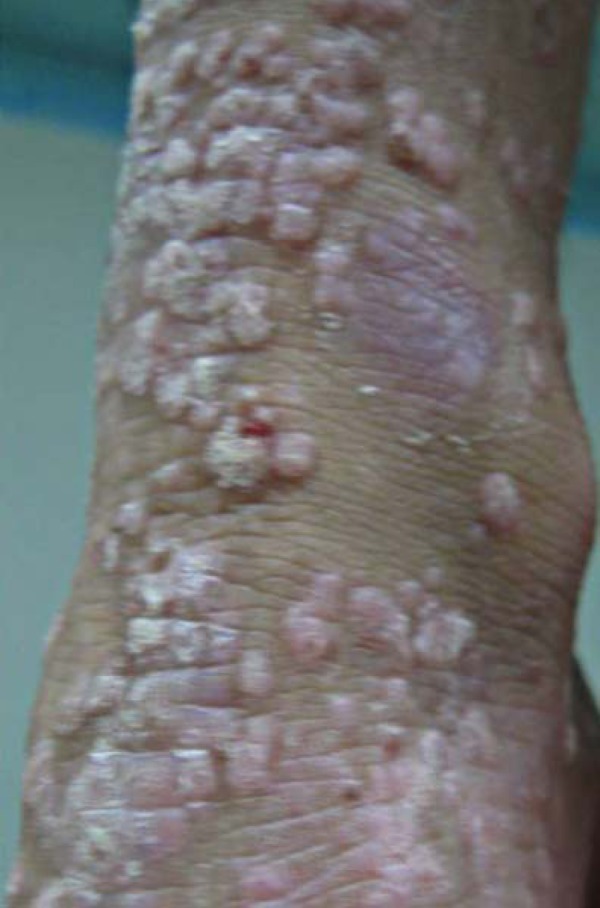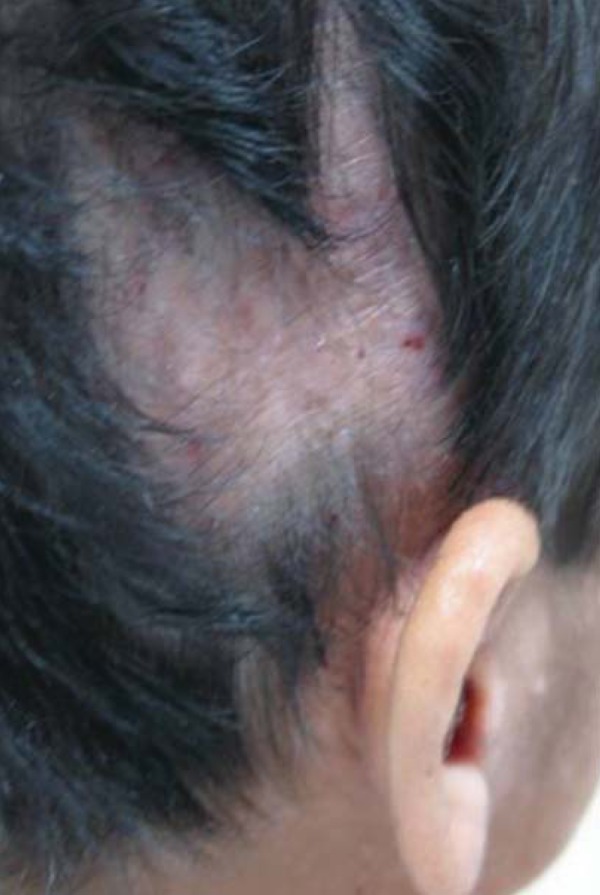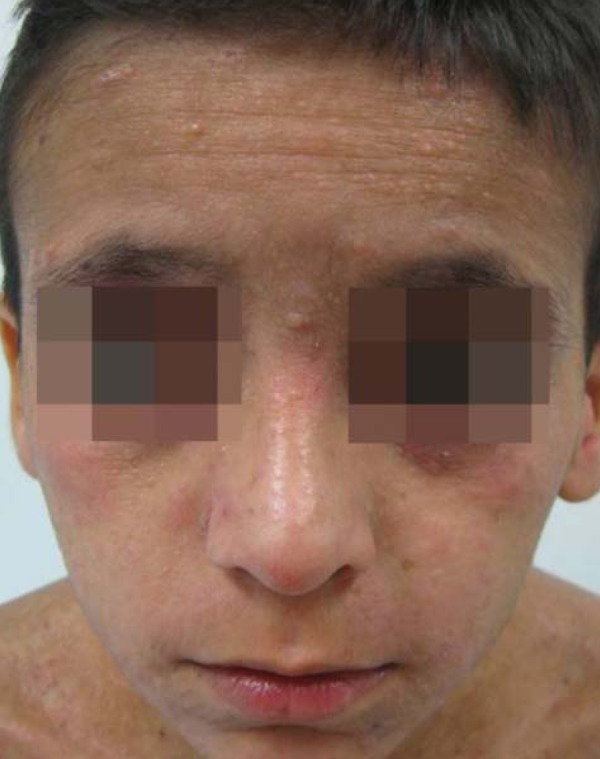Abstract
The hyperimmunoglobulin E syndrome, or Job's syndrome is a rare primary immunodeficiency characterized by recurrent skin abscesses, recurrent respiratory tract infections, and high levels of IgE, eosinophilia, bone and dental changes. We report the case of a fourteen-year-old male patient presenting this disease, with both typical and also some relatively sporadic manifestations. We performed a literature review on the syndrome and its associated clinical findings.
Keywords: Immunoglobulins, Job's Syndrome, Molluscum contagiosum virus
Abstract
A síndrome de hiperimunoglobulinemia E, ou síndrome de Job é uma imunodeficiência primária rara, caracterizada por abcessos cutâneos recorrentes, infecções de repetição do trato respiratório, títulos elevados de IgE, eosinofilia, alterações ósseas e dentárias. Relata-se o caso de um paciente do sexo masculino, 14 anos, portador da doença, com manifestações desde típicas a algumas relativamente esporádicas, fazendo-se uma revisão da síndrome e dos achados clínicos associados.
CASE REPORT
Fourteen-year-old male patient, born and resident in São João dos Patos (Maranhão State), was seen at the HRAN/SES/DF Dermatology Service, with a history of keratotic papulonodular-verrucous lesions on the torso, and both upper and lower limbs. He also presented with areas of alopecia and an extremely pruriginous retroauricular lichenification (Figures 1 and 2).
FIGURE 1.

Multiple scarified keratotic papules on the lower third of the right leg and top of the right foot
FIGURE 2.

Alopecic area with lichenification and scarification on the surface of the left temporal-occipital region
The patient had a prominent forehead and a broad nose (Figure 3). He had antecedents of: pneumonia, otitis and recurrent diarrhea since four months of age. His brother died of pneumonia at four months of age; and there was no history of familial consanguinity. Laboratory work-up showed: leukocytosis (60.900/mm3) with eosinophilia (90%), IgE levels of 11.600 mg/dL; negative anti-HIV 1 and 2 tests and negative anti-Toxocara and anti-Aspergillus. Besides the atopic eczema, we diagnosed multiple vulgar warts and molluscum contagiosum.
FIGURE 3.

Prominent front and broad nose base with multiple papules, some with umbilicated and other with keratotic surfaces
DISCUSSION
Hyperimmunoglobulin E Syndrome, also known, as Job's Syndrome is a rare primary immunodeficiency characterized by recurrent cutaneous abscesses, repeated respiratory tract infections and elevated serum levels of IgE. 1-5 This is an autosomal dominant disease, with sporadic cases detected, for which there is neither a predominant gender or race incidence. 1-5
Mutations on STAT3 (Signal Transducer and Activator of Transcription) gene, mapped on chromosome 4q, were recently described for this syndrome. 3 STAT3 has a crucial role in transducing the signals of a large spectrum of cytokines and is involved in the IL-6 mediated regulation of TH17 cells, an important step for the control of fungal and bacterial infections. 3,6 Cellular immunity is abnormal in patients with this syndrome. The most common functional defects in the host's immune system are the down-regulation of Tsuppressor cell function and neutrophil chemotaxis. 5,7 Therefore, patients with hyperimmunoglobulin E syndrome frequently present with cutaneous abscesses, impetigo, furunculosis, paronychia, cellulitis and recurrent Staphylococcus aureus pneumonias. Other causal agents of pulmonary infections are: Aspergillus spp e Pneumocystis jiroveci. 2
Patients with this disease often report intense and chronic pruritus, associated to dermatitis. The pruritus is attributed to histamine release by the mast cells in the dermis, which are stimulated by the high levels of IgE. Peripheral eosinophilia is a typical feature, reaching levels of 50 to 60%. Serum levels of IgE are consistently high (over 10 times the superior threshold of normal levels) and present from infancy. There is an association of this disease with the presence of scoliosis in adult patients and also with hyperextensibility of joints, occurring in 76 and 68% of the cases respectively. 5
Other frequent clinical features are: candidiasis, dental abnormalities, prominent front and supraorbital ridges and broadening of the base of the nose. 1-6 Dermatoviroses, such as molluscum contagiosum and viral warts are common, mainly on areas with eczema. Those are difficult to treat, persisting for long periods of time. 4,8 Ocular complications are infrequent, but might occur as keratoconus, staphylococcic chalazia with blepharitis and endophthalmitis, and other severe situations such as retinal detachment. 5
We presented here the case of a patient with several manifestations of the disease, including: papulonodular-verrucous lesions (warts and molluscum contagiosum), pruriginous areas (chronic eczema), prominent front, broad nose, recurrent pneumonias, eosinophilia and very high serum levels of IgE. There is not a specific treatment for this syndrome, only control of the dermatologic lesions with emollients, topical and systemic antibiotics, and control of the dermatoviroses through cryotherapy, curettage, imiquimod, retinoids and alpha-interferon. 4,7 The prophylactic use of sulfamethoxazole and trimethoprim, in order to avoid recurrent staphylococcal infection is recommended. 7
Footnotes
Financial Support: None
Conflict of Interests: None
* Work performed at the Hospital Escola - Hospital Regional Da Asa Norte (HRAN) - Brasília (DF), Brazil.
REFERENCES
- 1.Reis RC, Holanda MA, Câmara JP, Araújo JH, Aquino MP, Santana LBC. Síndrome de Jó ou hiperimunoglobulinemia E. J Pneumol. 2001;27:115–118. [Google Scholar]
- 2.Freeman AF, Davis J, Anderson VL, Barson W, Darnell DN, Puck JN, et al. Pneumocystis jivoreci infection in patients with hyper-immunoglobulin E syndrome. Pediatrics. 2006;118:1271–1275. doi: 10.1542/peds.2006-0311. [DOI] [PubMed] [Google Scholar]
- 3.Holland SM, De Leo FR, Elloumi HZ, Hsu AP, Uzel G, Brodsky N, et al. STAT3 mutations in the hyper-IgE syndrome. N Engl J Med. 2007;357:1608–1619. doi: 10.1056/NEJMoa073687. [DOI] [PubMed] [Google Scholar]
- 4.Kilic SS, Kilicbay F. Interferon-alpha treatment of molluscum contagiosum in a patient with hyperimmunoglobulin E syndrome. Pediatrics. 2006;117:1253–1255. doi: 10.1542/peds.2005-2706. [DOI] [PubMed] [Google Scholar]
- 5.Arora V, Kim UR, Khazei HM, Kusagur S. Ophthalmic complications including retinal detachment in hyperimmunoglobulinemia E (Job's) syndrome: Caso report and reviw of literature. Indian J Ophthalmol. 2009;57:385–386. doi: 10.4103/0301-4738.55076. [DOI] [PMC free article] [PubMed] [Google Scholar]
- 6.Hsu AP, Davis J, Puck JM, Holland SM, Freeman AF. Autosomal Dominant Hyper IgE Syndrome. In: Pagon RA, Bird TD, Dolan CR, Stephens K, Adam MP, editors. GeneReviews. Seattle, WA: University of Washington, Seattle; [uptated 2010 Feb 23]. [cited 2012 Jun 7]. 1993. Available from: http://www.ncbi.nlm.nih.gov/books/NBK25507. [Google Scholar]
- 7.Venkata C, Ghafoor S, Venkateshiah SV. A 35-year-old man with recurrent pneumonias, eczema, coarse facial features, and cystic lung lesions. Chest. 2010;133:1026–1029. doi: 10.1378/chest.07-2148. [DOI] [PubMed] [Google Scholar]
- 8.Molina L, Romiti R. Molluscum contagiosum on tattoo. An Bras Dermatol. 2011;86:352–354. doi: 10.1590/s0365-05962011000200022. [DOI] [PubMed] [Google Scholar]


